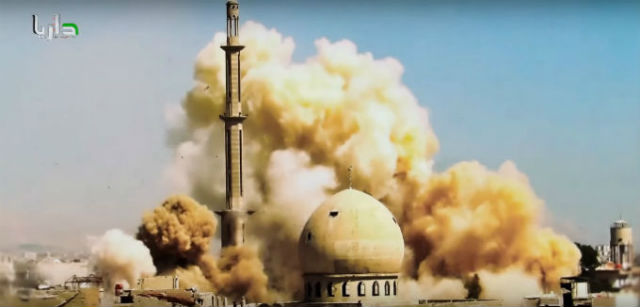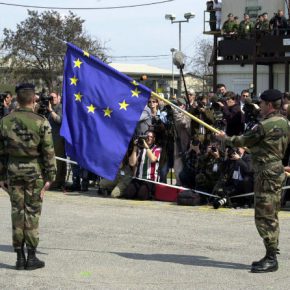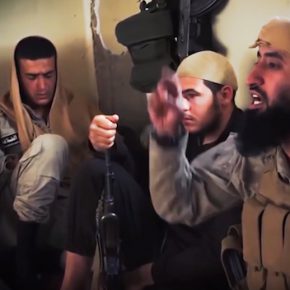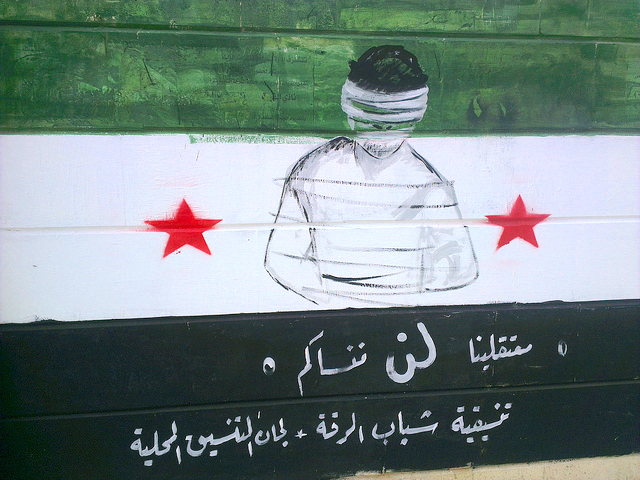As the Syrian government and its allied militias evacuate mostly Sunni populations from rebel-held areas, sectarian narratives are filling the vacuum.
BEIRUT – On Monday, the first day of the Muslim holiday Eid al-Adha, Syrian president Bashar al-Assad, surrounded by a phalanx of supporters, made a triumphant victory lap through the ghostly, bombed-out ruins of Darayya. The town, about five miles southwest of Damascus, was an icon of the Syrian uprising until late August, when Assad’s government wrested it back from rebel control. Kneeling on the floor of the Sa’d ibn Muaz mosque, the president performed Eid prayers with the mufti of Damascus and vowed to “rebuild everything that has been destroyed” and “retake every inch of Syria from the terrorists.”
But Assad’s prayer was not the first public prayer from defeated Darayya. And in the arena of political symbols, it was not, perhaps, the most significant. On September 2, a week after the government retook control, an Iraqi cleric named Amjad al-Bahadleh led Friday prayers in the ruins of Darayya. As the cleric bowed his head, flanked by a fighter with a machine gun, a row of men genuflected behind him on prayer rugs laid over the rubble. They all wore combat fatigues, except for one on the end, whose T-shirt said: “No War.”
Darayya has always been decisive. For Christians, it is the spot on the road to Damascus where the Apostle Paul heard the Lord’s voice and converted to Christianity. The Iraqi cleric’s prayer in Darayya was a snapshot of the Syrian conflict at a moment of increasing polarization: Depending on your point of view, it was either a gloating celebration of sectarian cleansing, a pious commemoration of a holy shrine just liberated from terrorists, evidence of the hollowness of the Syrian state – or all of the above. No matter which interpretation, the prayers in Darayya captured an ongoing process of sectarianization that will be difficult to reverse.
“Whether it is on the side of the opposition or on the side of the regime, you’ve seen an appeal to sectarian identities in an attempt to mobilize local and transnational forces,” said Bassel Salloukh, a professor of political science at the Lebanese American University who has written on sectarianization in the region. “The problem is that once you do that, once you securitize sectarian identities, then people start thinking of them as fixed and primordial and the only markers of political identity.”
The worshippers were fighters from the Liwa’ Imam Hussein (the Brigades of Imam Hussein), a Shiite militia from Iraq that has been fighting alongside the Syrian government’s 4th Armored Division. Over the past four years, as the government battled rebel groups for control of the outskirts of Damascus, it has relied more and more heavily on a network of Shiite militias from Iraq and Lebanon. The brigades “had long participated in the siege of Darayya,” said Aymenn Jawad al-Tamimi, a research fellow at the Middle East Forum. “So it wasn’t surprising that in the end they would make some show of victory there by holding prayers in the abandoned suburb.”
In 2011, as the uprising began, Darayya was famous for nonviolent demonstrations where protesters brought roses and water to government soldiers. Since then, the city’s fate has followed that of the uprising itself: brutal bombardment and massacres during the fight for control, followed by four years of bitter starvation and siege by pro-government forces after the town fell under rebel control in 2012.
In late August, warplanes launched a brutal air assault on Darayya with incendiary weapons. Less than a week before Bahadleh’s prayer, the entire population of Darayya was forcibly evacuated in a truce agreement that was a humiliating rebel surrender: fighters and their families were evacuated to the northern province of Idlib, while civilians were relocated to government shelters. Other rebel-held areas, such as Mouadamiya, another suburb of Damascus, and the Waer neighborhood in Homs, were forced into similar population transfer agreements.
https://www.youtube.com/watch?v=2_6p7JnEzfk
As the Syrian government and its allied militias have begun evacuating mostly Sunni populations from rebel-held areas, sectarian narratives are gaining primacy. Shiites and other minorities express fears of massacres by “terrorists” – a term that the government and its allies often use to lump together the originally multi-sectarian Free Syrian Army (FSA) with Sunni Islamist groups like the Levant Conquest Front and the so-called Islamic State. Sunnis express fears that the evacuations are a precursor to an ethno-sectarian division of the country – an idea that many Syrians reject, but that remains beloved by outside power brokers.
After Darayya was evacuated, a group of Sunni Islamist militias issued a bayan, or communiqué, that explicitly accused the government of sectarian cleansing. Titled “Blood, Blood … Destruction, Destruction,” it accuses “the vengeful Nusayri regime” – using a derogatory term for Alawites, the minority sect to which Assad belongs, and which is often sloppily described as an “offshoot” of Shiite Islam – of having a “systematic plan to change the demographics of the area.” It then threatened to attack civilians in government-held neighborhoods and “murderous villages.” ISIS made good on that threat on September 5, when a wave of bombings killed 47 people in mostly government-held areas of Syria.
The recent evacuation made Bahadleh’s public prayer look like a declaration not just of military victory, but also mass displacement. “It’s seen as a show of Shia triumphalism,” said Tamimi. “That obviously contributes to this sectarian polarization we see in Syria.”
But as Tamimi points out, the prayer was directed mostly at Shiite audiences. For Shiite Muslims, Darayya is home to a shrine containing the remains of Sayyida Sakina (also known as Ruqayya), the infant daughter of Imam Hussein, grandson of the prophet Muhammad. In the battle of Karbala, which cleaved Islam into its two major sects, Hussein was killed and Sakina was taken captive to Damascus, where she died. Her shrine is a sister to that of Sayyida Zeinab in Damascus, which draws Shiite pilgrims from all over the region. Earlier this year, ISIS targeted Sayyida Zainab with multiple suicide bombings.
https://www.youtube.com/watch?v=tm9jSWzZsIo
Defending shrines in Syria against militias – whose fighters have reportedly desecrated Shiite shrines in the past – has been an important rallying cry for foreign fighters from neighboring countries. But non-Shiites often dismiss Sakina’s tomb as “the alleged shrine” or “ the purported shrine,” reflecting the view that the government is using the shrine as a pretext for persecuting rebels – many of whom are Sunnis. (Sunni Muslims make up two thirds of Syria’s population.)
During the course of various battles, the shrine of Sakina was heavily damaged, with both sides blaming each other. In early 2015, the FSA captured it. This became a rallying cry for the government and its allied militias, who used the shrine’s symbolic value to motivate fighters. “This idea of liberating the shrine from the control of terrorists was another of these narrative points,” said Tamimi.
The extent to which these narratives are constructed by different players – the government, the militias, outside funders like Iran and Saudi Arabia, who are fighting multiple proxy wars across the region – is itself a matter of debate. One of the Syrian conflict’s bitterest ironies is that most of the combatants don’t hesitate to exploit sectarian fears, while, at the same time, accusing the others of sectarianizing the conflict.
Many scholars agree that sectarianism is not the primary driver of the Syrian conflict. “Syria, like Iraq, has always been a country where you have overlapping identities and multiple identities,” said Salloukh. “People can embrace a regional identity, a class identity, a sectarian identity – and, of course, which one of these identities is prioritized is a function of the situational and political variables or factors.”
But the idea of splitting Syria into statelets or zones of influence is not new. When France occupied Syria after World War I, the French authorities set up four statelets, including an Alawite mini-state in the coastal mountain regions. It also promoted young Alawite men into special auxiliary forces composed of “friendly” minorities such as Alawites, Armenians and Circassians.
In 1925, Syrians rebelled against French rule. The uprising spread across the country, lasted about three years, and was, until 2011, the largest and most sustained rebellion of the modern Middle East. The French military used its auxiliary fighting units to put down the rebellion, which was led mostly by Sunnis and Druze. Then, as now, divide-and-conquer proved a useful strategy – at least in the short term.
In the 1925 rebellion, some of the bloodiest battles took place in the Ghouta, the ring of agricultural lands that arcs around most of Damascus. When the 2011 uprising began, many of the fiercest pockets of rebellion, including Darayya, were in the Ghouta. These pockets of resistance were non-sectarian at first. But most of them were taken over – often violently – by Sunni Islamist groups. The ISIS putsch in the besieged neighborhood of Yarmouk, just south of Damascus, is a case in point: after months of infiltration and assassinations of non-sectarian leaders, the group finally invaded in April 2015.
Darayya was a notable exception: Until the end, the local civilian coordinating committee ran its affairs. In its defeat and ultimate surrender, some see a harbinger of further sectarian divisions. “What we’re seeing happening in Syria in the recent evacuations is, I think, a big part and parcel of these kinds of civil wars, which take on a kind of ethnic or sectarian dimension,” said Salloukh. “It’s the transfer of populations to create new demographies.”
This article originally appeared on Syria Deeply, and you can find the original here. For important news about the war in Syria, you can sign up to the Syria Deeply email list. Photograph courtesy of Darayya Revolution. Published under a Creative Commons license.





